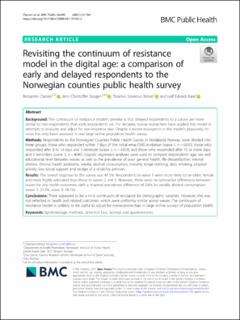| dc.contributor.author | Clarsen, Benjamin Matthew | |
| dc.contributor.author | Skogen, Jens Christoffer | |
| dc.contributor.author | Nilsen, Thomas Sevenius | |
| dc.contributor.author | Aarø, Leif Edvard | |
| dc.coverage.spatial | Norway | en_US |
| dc.date.accessioned | 2021-05-12T09:34:27Z | |
| dc.date.available | 2021-05-12T09:34:27Z | |
| dc.date.created | 2021-05-06T13:43:18Z | |
| dc.date.issued | 2021-04 | |
| dc.identifier.citation | Clarsen, B., Skogen, J.C., Nilsen, T.S., Aarø, L.E. (2021) Revisiting the continuum of resistance model in the digital age: a comparison of early and delayed respondents to the Norwegian counties public health survey. BMC Public Health, 21 | en_US |
| dc.identifier.issn | 1471-2458 | |
| dc.identifier.uri | https://hdl.handle.net/11250/2755136 | |
| dc.description.abstract | Background
The continuum of resistance model’s premise is that delayed respondents to a survey are more similar to non-respondents than early respondents are. For decades, survey researchers have applied this model in attempts to evaluate and adjust for non-response bias. Despite a recent resurgence in the model’s popularity, its value has only been assessed in one large online population health survey.
Methods
Respondents to the Norwegian Counties Public Health Survey in Hordaland, Norway, were divided into three groups: those who responded within 7 days of the initial email/SMS invitation (wave 1, n = 6950); those who responded after 8 to 14 days and 1 reminder (wave 2, n = 4950); and those who responded after 15 or more days and 2 reminders (wave 3, n = 4045). Logistic regression analyses were used to compare respondents’ age, sex and educational level between waves, as well as the prevalence of poor general health, life dissatisfaction, mental distress, chronic health problems, weekly alcohol consumption, monthly binge drinking, daily smoking, physical activity, low social support and receipt of a disability pension.
Results
The overall response to the survey was 41.5%. Respondents in wave 1 were more likely to be older, female and more highly educated than those in waves 2 and 3. However, there were no substantial differences between waves for any health outcomes, with a maximal prevalence difference of 2.6% for weekly alcohol consumption (wave 1: 21.3%, wave 3: 18.7%).
Conclusions
There appeared to be a mild continuum of resistance for demographic variables. However, this was not reflected in health and related outcomes, which were uniformly similar across waves. The continuum of resistance model is unlikely to be useful to adjust for nonresponse bias in large online surveys of population health. | en_US |
| dc.language.iso | eng | en_US |
| dc.publisher | BioMed Central | en_US |
| dc.rights | Navngivelse 4.0 Internasjonal | * |
| dc.rights.uri | http://creativecommons.org/licenses/by/4.0/deed.no | * |
| dc.subject | folkehelse | en_US |
| dc.title | Revisiting the continuum of resistance model in the digital age: a comparison of early and delayed respondents to the Norwegian counties public health survey | en_US |
| dc.type | Peer reviewed | en_US |
| dc.type | Journal article | en_US |
| dc.description.version | publishedVersion | en_US |
| dc.rights.holder | © The Author(s). 2021 | en_US |
| dc.subject.nsi | VDP::Medisinske Fag: 700::Helsefag: 800::Samfunnsmedisin, sosialmedisin: 801 | en_US |
| dc.source.volume | 21 | en_US |
| dc.source.journal | BMC Public Health | en_US |
| dc.source.issue | 1 | en_US |
| dc.identifier.doi | 10.1186/s12889-021-10764-2 | |
| dc.identifier.cristin | 1908533 | |
| dc.source.articlenumber | 730 (2021) | en_US |
| cristin.ispublished | true | |
| cristin.fulltext | original | |
| cristin.qualitycode | 1 | |

